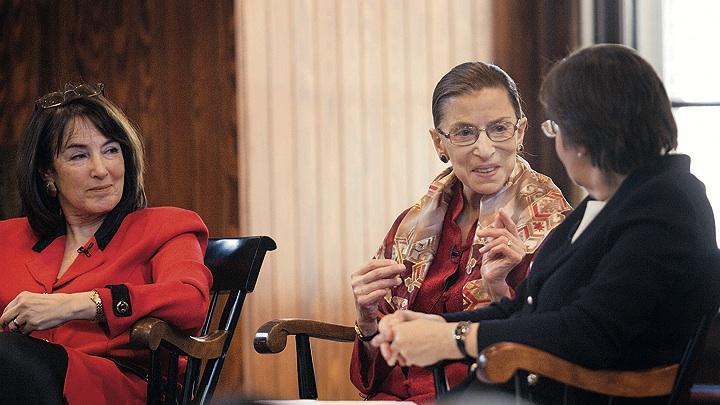Case by case, Ruth Bader Ginsburg, L ’59, has chipped away at laws that have disadvantaged women and reinforced notions of men as breadwinners and women as dependents: both as an attorney for the American Civil Liberties Union (ACLU) who argued cases before the Supreme Court, and as a justice on that very court. During a conference at the Radcliffe Institute for Advanced Study in March, the associate justice led listeners on a journey through the historic cases that overturned many of those laws; the path corresponded largely with her own life. (To view video coverage, visit www.radcliffe.edu/events/calendar_2009law.aspx.)
Her fellow panelists at the conference—titled “Gender and the Law: Unintended Consequences, Unsettled Questions”—wondered whether younger women today realize just how much has changed. They “have had the privilege of coming of age professionally in a world that Ruth Bader Ginsburg helped to make,” said moderator Linda Greenhouse ’68, who spent three decades covering the Supreme Court for the New York Times.
Ginsburg (who attended Harvard Law School, but finished her degree at Columbia) came of age as an attorney at the same time women’s rights were first coming to the Supreme Court’s attention. Until 1971, the justice said, the court had no doctrine on gender discrimination. That year, she wrote a brief in Reed v. Reed, which challenged an Idaho probate law that said “males must be preferred to females” in appointing estate administrators. (At the time, many states had similar language on their books, she recalled.) It was the first Supreme Court case she worked on in which the court issued a decision, and was an auspicious start: the Court ruled in her client’s favor.
Ginsburg founded the ACLU Women’s Rights Project in 1972 and, in the eight years before her appointment as a federal judge, argued or wrote briefs in more than a dozen major women’s-rights cases. Especially in the beginning, she said, it was important to choose sympathetic cases: those whose plaintiffs were demographically similar to the Supreme Court, and sometimes similar in gender to members of the Court, as well, on the premise that any discrimination on the basis of gender was unconstitutional—not just discrimination against women. In one such case, 1975’s Weinberger v. Wiesenfeld, the Court struck down a federal law that had entitled widows, but not widowers, to child-in-care benefits after a spouse’s death.
And it was also important to recognize that full equality of citizenship carried responsibilities as well as rights, Ginsburg said, citing Duren v. Missouri, a Supreme Court case she won in 1979. In what would be the last case she argued before the Court (she was appointed a federal judge in 1980, and served until her 1993 appointment as a justice), she maintained that a Missouri law making jury duty optional for women should be struck down because it treated women’s service on juries as less valuable than men’s.
Panelist Sandra Lynch—who last year became the first female chief judge of the U.S. Court of Appeals for the First Circuit—recalled attending Boston University Law School (from which she graduated in 1971) when it was considered radical for admitting enough women to constitute 10 percent of each incoming law class. Lynch described the open hostility that some of her law professors directed toward female students; U.S. district judge Nancy Gertner, who graduated from Yale Law School the same year, recalled interviewing for a prestigious clerkship and being asked whether she ever planned to marry and have children. “I told him, ‘Of course not,’” she recalled. (She now has two.)
Because discrimination today is subtle rather than explicit, Lynch and Gertner said they worry that young women will fail to see threats to their equality and lose ground inadvertently.
As President Drew Faust—the former Radcliffe Institute dean who has broken a major gender barrier herself—listened in the first row, Ginsburg admitted that her zeal for gender equality explained, at least in part, her quick recovery from surgery for pancreatic cancer earlier this year. She returned to work less than three weeks after the surgery, and the same week attended a major public address by President Barack Obama. When asked by USA Today why she insisted on attending, she answered, “I wanted people to see that the Supreme Court isn’t all male.” (She is the second female justice; Sandra Day O’Connor was appointed in 1981 and retired in 2006.)
But Ginsburg voiced less concern about backsliding than her fellow panelists. She closed by saying that given how much has changed in a single generation, “I remain optimistic about the potential of the United States.”








